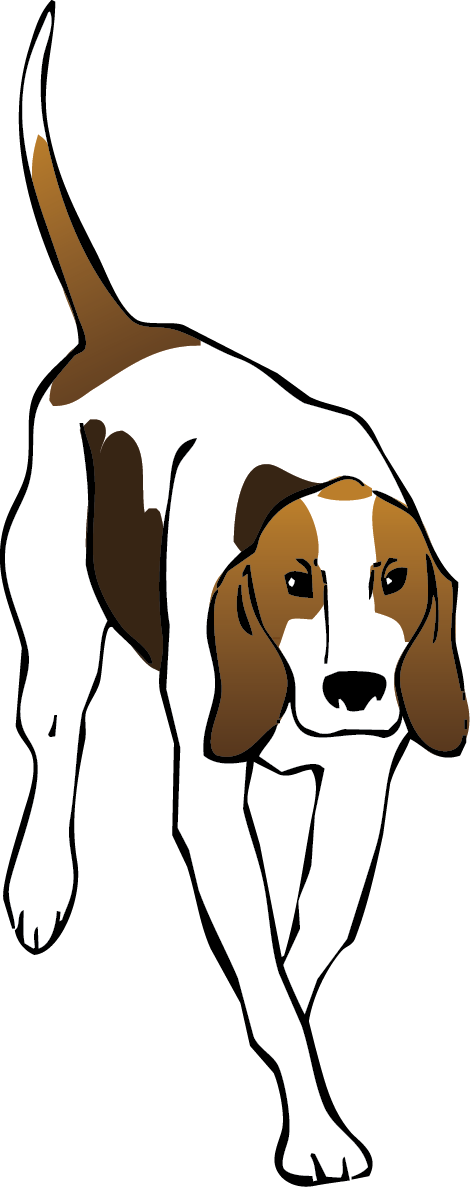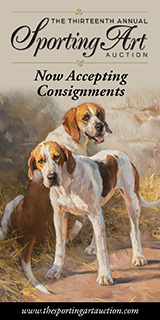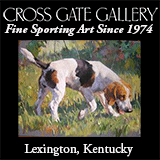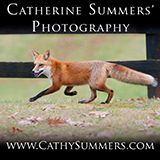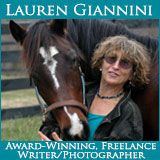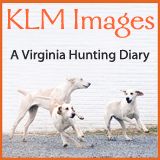steeplechasing
University of Arizona Offers Race Track Industry Curriculum
The University of Arizona in Tuscon offers a course of study for aspiring race track industry executives and officials. The university’s Race Track Industry Program (RTIP) is the only Bachelor of Arts and Masters Degree program of its kind, specific to the pari-mutuel racing industry. RTIP students have two options to follow toward their degree—the Business Path or the Equine Management Path. The first prepares students for employment in the areas of race track management, regulation, and pari-mutuel racing organizations. The second prepares students for employment in areas dealing with racing and breeding. A recent graduate is foxhunter/race rider McLane Hendriks from Coatesville, Pennsylvania who rode in the Maryland Hunt Cup just last spring. Hendriks grew up foxhunting, competing in pony jumper shows, and pony racing. In 2007 he was awarded the Junior Steeplechase Rider of the Year title. Hendriks received his Bachelor of Science degree in December after completing his studies in the RTIP. Hendriks and his fellow students received specialized instruction in racing operations, marketing, and racing law. Industry speakers are engaged to give the students real-world insights. During the past summer, Hendriks worked as an intern for Georganne Hale, Director of Racing and Racing Secretary for the Maryland Jockey Club at Pimlico Racecourse. He gained hands-on experience taking entries and accompanying the paddock judge, placing judges, and race stewards. Through the RTIP, Hendriks also was also able to network with industry professionals at the university’s Global Symposium on Racing and Gaming. Held annually for attendees representing horse racing and greyhound racing world-wide, the symposium presents speakers and panel sessions discussing industry subjects and current trends, including simulcasting, account wagering, track surfaces, casino gaming, health issues, operations, technology, and regulation. RTIP students are involved as committee members in registration, publications, exhibits, and audio/visual services in this, what the university claims to be the world’s largest racing industry conference. According to the RTIP website, few other educational programs provide this kind of access and networking with high-level members from the industry that will ultimately employ its students. Posted January 10, 2015
Read More
Photographer Douglas Lees Awarded S. Bryce Wing Trophy
Janet Hitchen photoTwo-time Eclipse Award-winning photographer Douglas Lees was this year’s recipient of the S. Bryce Wing Trophy, awarded by the Maryland Hunt Cup Association to honor individuals who have made exceptional contributions to Maryland timber racing. Lees is a regular contributor to Foxhunting Life, and we congratulate him for his latest achievement.
With one foot in racing and one foot in foxhunting, Lees is a double threat. Each spring, during the point-to-point season, Lees sends us his brilliant racing photographs to enliven our coverage of the hunt races, and we publish his foxhunting images regularly. In fact, the cover photo of huntsman Spencer Allen and the Piedmont foxhounds for our just-published 2015 Foxhunting Life calendar was taken by Lees.
Why We Cover the Hunt Races
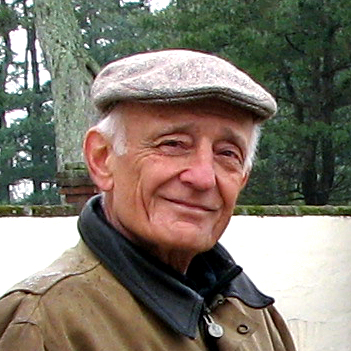 My answer to the question is threefold: first, the very notion of the point-to-point race originated with foxhunters; second, many of our great field hunters have come from the ranks of the timber horses, and conversely many of the best steeplechase horses have their start in the hunting field; and third, most of the steeplechase jockeys are foxhunters as well.
My answer to the question is threefold: first, the very notion of the point-to-point race originated with foxhunters; second, many of our great field hunters have come from the ranks of the timber horses, and conversely many of the best steeplechase horses have their start in the hunting field; and third, most of the steeplechase jockeys are foxhunters as well.
As Catherine Austen reminds us in Thoroughbred Owner & Breeder, “Hunt racing has its roots firmly lodged in the hunting field. Point-to-pointing started when two hunting men, Edmund Blake and Cornelius O’Callaghan, challenged each other to a race in 1752 for four-and-a-half miles across country from Buttevant Church to Donraile Church in County Cork. They jumped everything in their path, and by keeping the steeple of Donraile Church in sight (steeple-chasing), the two men kept to the planned route along the banks of the Awbeg River. The same line can still be taken while hunting with the Duhallow Foxhounds now.
“Amateur jump racing evolved from there....”
Why We Cover the Hunt Races
The first point-to-point race of the 2022 season is scheduled in Virginia for March 5 (rain date, March 12). The eighth and final hunt point-to-point of the season will be run on May 1. Foxhunting Life reports on most of these jump races as the season progresses. Some readers across North America might wonder why.
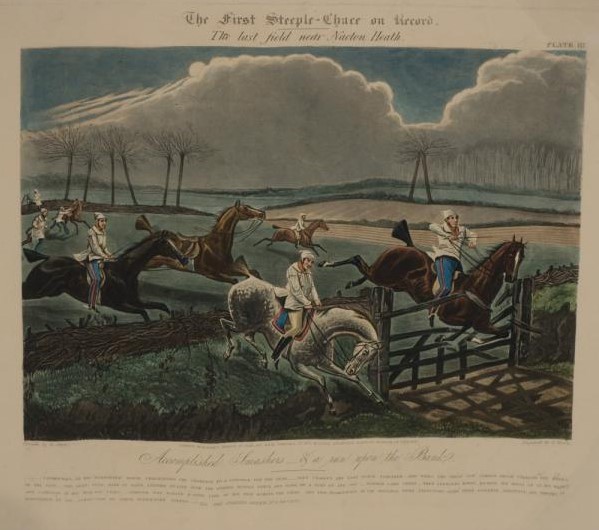
My answer is threefold: first, the very notion of a steeplechase race originated with foxhunters; second, many of our great field hunters have come from the ranks of the timber horses and conversely, many of the best steeplechase horses have their start in the hunting field; and third, most of the steeplechase jockeys are foxhunters as well.
Why We Cover the Hunt Races
 My answer to the question is threefold: first, the very notion of the point-to-point race originated with foxhunters; second, many of our great field hunters have come from the ranks of the timber horses, and conversely many of the best steeplechase horses have their start in the hunting field; and third, most of the steeplechase jockeys are foxhunters as well.
My answer to the question is threefold: first, the very notion of the point-to-point race originated with foxhunters; second, many of our great field hunters have come from the ranks of the timber horses, and conversely many of the best steeplechase horses have their start in the hunting field; and third, most of the steeplechase jockeys are foxhunters as well.
As Catherine Austen reminds us in Thoroughbred Owner & Breeder, “Hunt racing has its roots firmly lodged in the hunting field. Point-to-pointing started when two hunting men, Edmund Blake and Cornelius O’Callaghan, challenged each other to a race in 1752 for four-and-a-half miles across country from Buttevant Church to Donraile Church in County Cork. They jumped everything in their path, and by keeping the steeple of Donraile Church in sight (steeple-chasing), the two men kept to the planned route along the banks of the Awbeg River. The same line can still be taken while hunting with the Duhallow Foxhounds now.
“Amateur jump racing evolved from there....”
Thornton Hill Fort Valley Hounds Kick Off Virginia Race Season
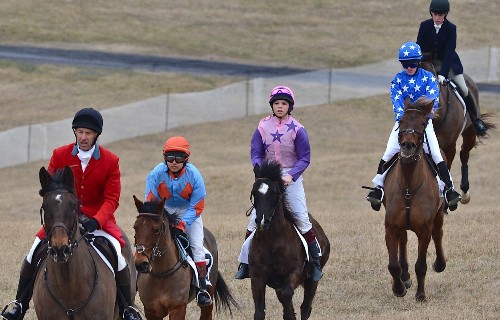 In the Junior Field Masters Chase, Brett Jackson, MFH leads (l-r) Erin Swope on Jordan, Kelly Witte on Missy (small pony winner), and Emme Fullilove on Sparta (large pony winner). / Douglas Lees photo
In the Junior Field Masters Chase, Brett Jackson, MFH leads (l-r) Erin Swope on Jordan, Kelly Witte on Missy (small pony winner), and Emme Fullilove on Sparta (large pony winner). / Douglas Lees photo
Thornton Hill Fort Valley Hounds opened the Virginia point-to-point season on Saturday, March 2, 2013 at Thornton Hill Farm in Sperryville. The first race, the Field Masters Chase for horses and small and large ponies, was followed by four races over hurdles, two flat races, and three timber races.
Kelly Witte on Missy, last year’s leading small pony, came to the wire six lengths behind the large ponies and won her division. Last year’s large pony champion Jordan ran just behind the Field Master but lost his rider Erin Swope at the last fence, giving Sparta the win with Emme Fullilove aboard. Emme also won the division for horses on GR’s Prize, holding off Erin Swope's Sweet Talking Guy in the stretch. Bay Cockburn saddled both winners.
Flying Change
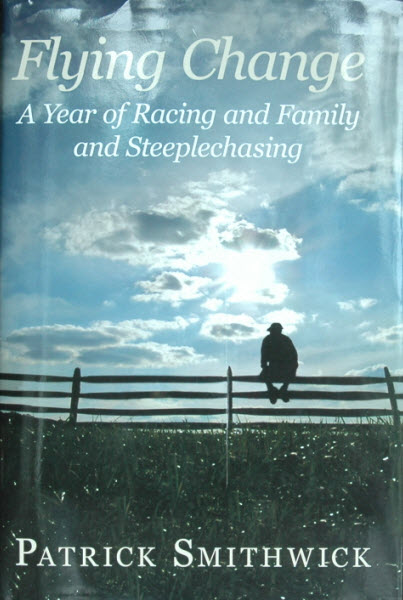 Flying Change: A Year of Racing and Family and Steeplechasing by Patrick Smithwick, Chesapeake Book Company, 2012, 360 pages, $30.00If you can avoid disabling injury, horseback riding is a sport that many enjoy for a lifetime. All of us have heard anecdotal tales of people who ride—and even foxhunt—up into their seventies and eighties.
Flying Change: A Year of Racing and Family and Steeplechasing by Patrick Smithwick, Chesapeake Book Company, 2012, 360 pages, $30.00If you can avoid disabling injury, horseback riding is a sport that many enjoy for a lifetime. All of us have heard anecdotal tales of people who ride—and even foxhunt—up into their seventies and eighties.
With Baby Boomers aging, those stories will become more prevalent, although many of us may be opting for the dressage arena instead of the hunt meet...or the race track.
Author Patrick Smithwick decided to meet growing older head on. He challenged himself at age forty-six to ride in the Maryland Hunt Cup, a four-mile timber race over twenty-two solidly built fences that are not for the faint of heart. It is the world’s stiffest timber race.
Jake Chalfin Wants Your Vote
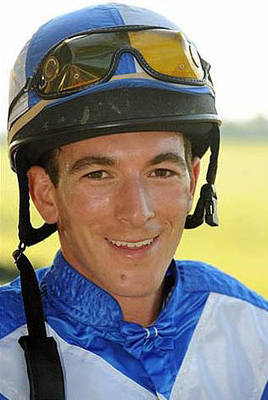 Jake ChalfinYour vote in the HRTV Film Festival at Santa Anita could steer “some serious prize money” to the Jake Chalfin Beneficiary Trust. Jake is a brave young man with a healthy attitude, and I hope you’ll watch his film and vote.
Jake ChalfinYour vote in the HRTV Film Festival at Santa Anita could steer “some serious prize money” to the Jake Chalfin Beneficiary Trust. Jake is a brave young man with a healthy attitude, and I hope you’ll watch his film and vote.
Foxhunting Life first reported on Jake in Norm Fine’s Blog of September 18, 2010 and in a follow-up article a year later. What follows is Jake’s latest adventure, in his own words:
I recently met a wonderful woman, Kristy Cecil, who was in from California visiting her folks who are my neighbors. This chance meeting opened a new chapter in my life. Kristy and I instantly found a connection and the next thing I knew we were making a film.
Jeff Murphy Has Two Winners at Orange County
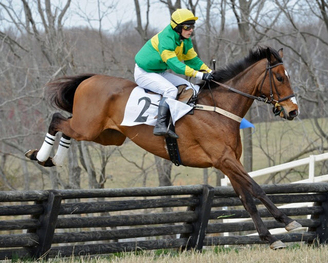 Jeff Murphy brought two winners home—one over timber, the other over hurdles—at the Orange County Point-to-Point on Sunday, April 3, at Locust Hill Farm in Middleburg, Virginia.
Jeff Murphy brought two winners home—one over timber, the other over hurdles—at the Orange County Point-to-Point on Sunday, April 3, at Locust Hill Farm in Middleburg, Virginia.
Murphy’s win on Aero (photo) in the Novice Timber race was a repeat performance of the pair’s previous win at Warrenton this spring. This time, Aero stalked fifth-place finisher Thynnus twice around the course. Five fences from the finish Aero went to the front, was overtaken by third-place finisher I’m A Hokie, regained the lead with two fences remaining, and drew away in the stretch to win by seven lengths. Aero is trained by Doug Fout and owned by Alfred C. Griffin, Jr.
Equestrian Sports and Oil Paintings: A Traditional Partnership
 Bundled at the Races by Linda Volrath, oilPainting is a poetic visual language. One of the most satisfying aspects of creating my paintings is using this language to translate a fleeting moment in a tangible and permanent way.
Bundled at the Races by Linda Volrath, oilPainting is a poetic visual language. One of the most satisfying aspects of creating my paintings is using this language to translate a fleeting moment in a tangible and permanent way.
I’m endlessly inspired and fascinated by the thrilling sports of steeplechase racing and foxhunting and the beautiful countryside that encompasses them. Incredible sights, sounds, and events unfold. Jockeys and grooms, athletic horses, hounds, and wildlife all have their role to play. I see my job as an artist to be the visual storyteller. The passion I have for these equine traditions and rural way of life seems perfectly paired with my passion to paint. It is a gold mine of images for my artistic vision.
